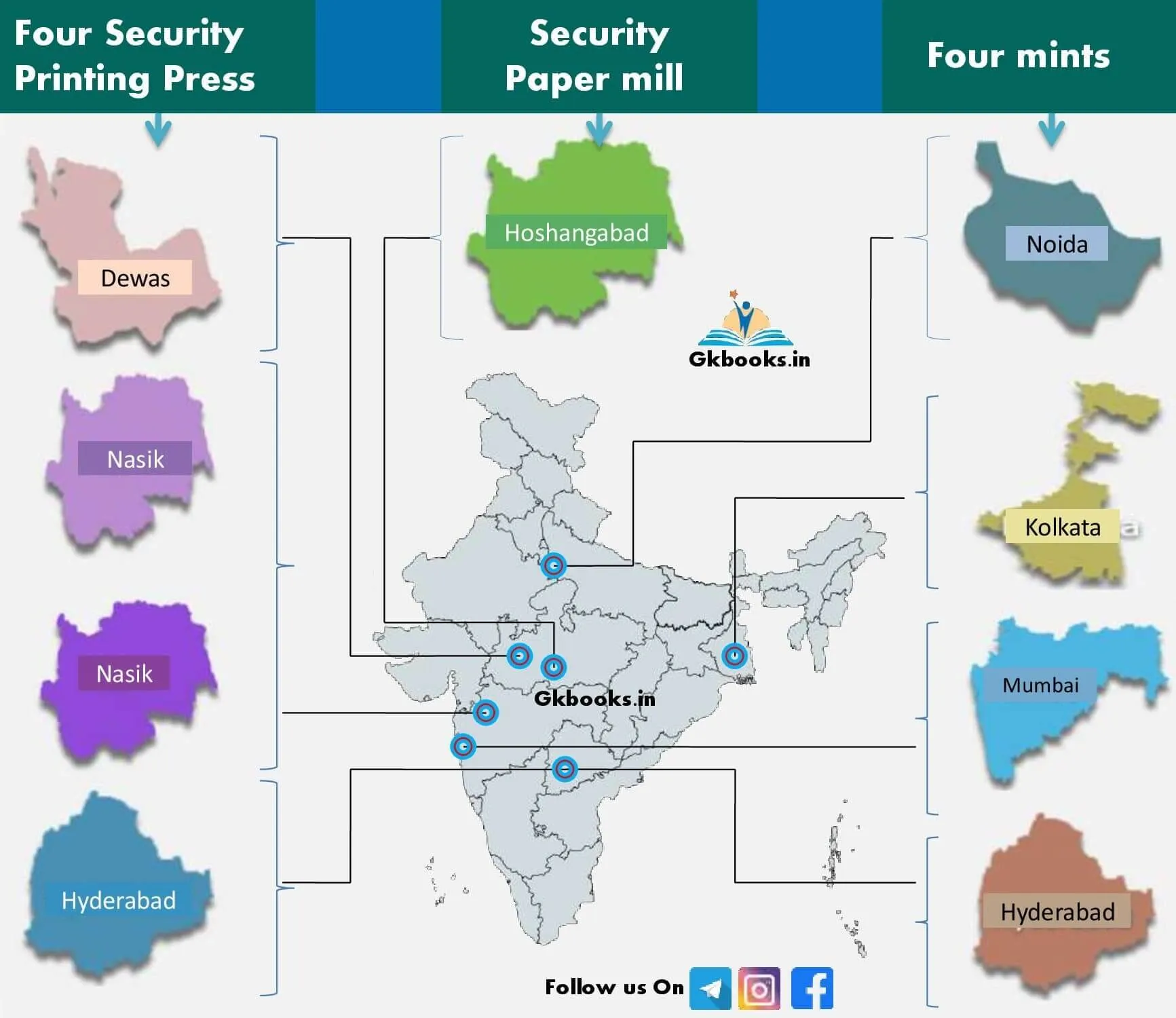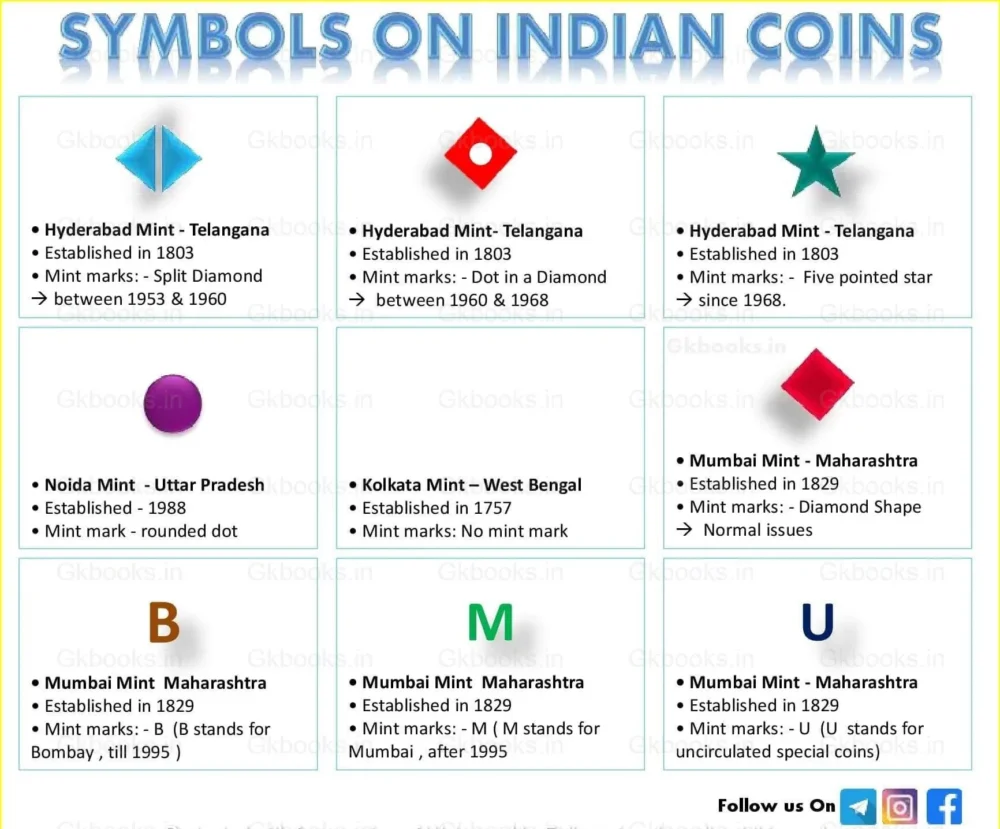The Indian economy is heavily dependent on its currency, which consists of both notes and coins. The notes are printed at various security presses located in different parts of the country. Coins feature symbols that carry specific meanings. This knowledge is important for students preparing for competitive exams, as understanding the Indian currency is an essential aspect of understanding the Indian economy.
It is important for students preparing for competitive exams to be familiar with these facts regarding Indian currency notes and coins.
Introduction
- The Reserve Bank of India has the sole authority to issue banknotes in India. (Except 1 rupee note)
- The 1 rupee note and the coins of all denominations are minted and issued by the Government of India.
- Although Rs 1 notes and coins are issued by the GOI, they are circulated by the Reserve Bank of India.
Read More: RBI Governors List from 1935 to 2024: Name, Eligibility, Powers, Tenure Complete Guide
Indian Currency Notes Currently Under Circulation
- In India, you’ll find banknotes in various denominations like ₹10, ₹20, ₹50, ₹100, ₹200, ₹500, and ₹2000.
- These notes are officially known as banknotes because they’re issued by the Reserve Bank of India.
- Interestingly, ₹2 and ₹5 notes are no longer being printed; instead, they’ve been turned into coins.
- This change was made because printing and managing these notes turned out to be more expensive compared to their lifespan.
- However, the ₹2 and ₹5 banknotes that were issued earlier, are still considered valid for transactions.
- Now, when it comes to ₹1 notes, these are issued by the Government of India from time to time.
- Both the current ₹1 notes and those issued in the past are completely acceptable as legal tender, meaning you can still use them for your transactions.
Demonetised Banknotes
- In January 1946, ₹500, ₹1000, and ₹10,000 banknotes that were in use were discontinued.
- Then, in 1954, higher denomination notes like ₹1000, ₹5000, and ₹10,000 were reintroduced. However, they faced demonetization again in January 1978.
- Moving forward to November 8, 2016, the ₹500 and ₹1000 banknotes from the Mahatma Gandhi Series were taken out of circulation and were no longer considered legal tender.
Also Read: RBI Monetary Policy, Instruments, Objectives, Types, Infographics, & More
New Currency Under Circulation
- A newly redesigned series of ₹500 and ₹2,000 banknotes has been circulated by RBI, since 10 November 2016.
- On 25 August 2017, a new denomination of ₹200 banknotes was added to the Indian currency structure
- In July 2018, the Reserve Bank of India released the redesigned series of ₹100 banknotes.
- As per the Reserve Bank of India Act, 1934 Currency notes can be issued up to the denominations of ₹ 10,000.
- The 1 rupee note is the only currency note that bears the signatures of the Finance Secretary of the government of India.
Why is One Rupee Note a liability of the Government of India?
- The One Rupee note is considered a liability of the Government of India because it falls under the Currency Ordinance, of 1940.
- These One Rupee notes are legally accepted as tender and are categorized as part of the broader term “Rupee coin” as per the Reserve Bank of India Act, 1934.
- Given that the rupee coins issued by the Government are regarded as the government’s responsibility, the One Rupee Note is also seen as a liability of the Government of India.
Indian currency coins under circulation
- The Government of India has the sole right to mint coins.
- Coins circulated under RBI comprise 50 paise and ₹1, ₹2, ₹5, ₹10, and ₹20 denominations.
- As of 2019, coins of the denomination of 1 rupee are the lowest value in use.
- The paisa was first introduced on 1 April 1957 after the decimalization of the Indian rupee.
- In 1955, The Government of India adopted the “metric system for coinage” in 1955.
- From 1957 to 1964, the paisa was called naya paisa.
- On 1 June 1964, the term “naya” was dropped.
- As per the Indian Coinage Act, of 2011, coins can be issued up to the denomination of ₹ 1000.
- Coins up to 50 paise are referred to as ‘small coins,’ while those of one rupee and above are known as ‘Rupee Coins.’
- The government of India has demonetized the denominations of 1 paise, 2 paise, 3 paise, 5 paise, 10 paise, 20 paise and 25 paise.
- It’s important to note that all other coin denominations, featuring various sizes, themes, and designs issued by the Government of India under The Coinage Act, 2011, and circulated by the RBI, remain legal tender.
- When it comes to depositing coins with banks, there is no specified limit set by the RBI.
- Banks have the flexibility to accept any amount of coins from their customers. So, while specific coin denominations have been withdrawn, the rest continue to be accepted and used in daily transactions.
Fact about the Symbol of the Indian rupee
- Symbol or Sign of Indian rupee ➥ ₹
- The rupee sign was adopted in ➥ 2010.
- It was designed by ➥ Udaya Kumar Dharmalingam
- The symbol of the rupee is a combination of the Devanagari consonant “र” (ra) and the Latin capital letter “R” without its vertical bar similar to the R rotunda.
- The letters are derived from the word ‘Rupiah’ in ‘Hindi’ and Rupees in the English language
- The symbol has two horizontal lines with a little space.
- This horizontal line depicts the background of the tricolor of our national flag.
- The horizontal lines, also known as Shiro Rekha, and it is a unique feature of the Devnagri Script.
- The first series of coins with the new rupee sign started in circulation on 8 July 2011.
- Before this, India used “₨” and “Re” as the symbols for multiple rupees and one rupee, respectively.

Security Printing Press and Mints of India
- The Security Printing and Minting Corporation of India (SPMCIL) is responsible for the production of Currency and Banknotes, Commemorative Coins, etc.
- The SPMCIL is a statutory body, that works under the jurisdiction of the Ministry of Finance, Government of India.
- The SPMCIL was established on 13 January 2006.
- The headquarters of SPMCIL is located in New Delhi.
- The Security Printing & Minting Corporation of India Ltd. (SPMCIL) comprises nine units.
- 4 mints
- 4 presses
- and 1 paper mill
- These four mints are located in Mumbai, Kolkata, Hyderabad, and Noida.
- The four security presses are located in Hyderabad and Dewas, with two located in Nashik.
- The security paper mill is located at Hoshangabad, Madhya Pradesh.

Symbols on Indian Coins
| Mints / Location | Year | Mint Marks |
|---|---|---|
| Kolkata Mint (West Bengal) | 1757 | No mark |
| Mumbai Mint (Maharashtra) | 1829 | • Diamond Shape – Normal issues • B – B stands for Bombay (till 1995) • M – M stands for Mumbai (after 1995) • U – U stands for uncirculated special coins |
| Hyderabad Mint (Telangana) | 1803 | • Split Diamond – between 1953 & 1960 • Dot in a Diamond – between 1960 & 1968 • Five-pointed star – since 1968. |
| Noida Mint (Uttar Pradesh) | 1988 | Rounded dot |

All new Indian currency note images

Indian currency Coins Images

Color and Motifs of the Mahatma Gandhi New Series Notes
| Denominations | Dimensions | Color | Motif |
|---|---|---|---|
₹ 10 | 123 mm × 63 mm | Chocolate Brown. | Konark Sun Temple |
₹ 20 | 129 mm × 63 mm | green-yellow | Ellora Caves |
₹ 50 | 135 mm × 66 mm | Fluorescent blue. | Hampi with Chariot |
₹ 100 | 142 mm × 66 mm | Lavender | Rani Ki Vav |
₹ 200 | 146 mm × 66 mm | Bright Yellow | Sanchi Temple |
₹ 500 | 150 mm × 66 mm | Stone Grey | Red Fort |
₹ 2000 | 166 mm × 66 mm | Magenta | Mangalyaan |
Language Panel of Banknotes
- Indian rupee banknotes feature its value written in 17+1 languages, with Braille language added for the visually impaired.
- On the front side, the denomination is presented in both English and Hindi.
- The reverse side includes a language panel showcasing the denomination in 15 of the 22 official languages of India.
- These languages are arranged alphabetically and include Assamese, Bengali, Gujarati, Kannada, Kashmiri, Konkani, Malayalam, Marathi, Nepali, Odia, Punjabi, Sanskrit, Tamil, Telugu, Urdu, and Braille.
- This inclusive approach ensures accessibility and representation for diverse linguistic communities across the country.
| Denominations in central-level official languages (At below either ends) | ||||||||||
|---|---|---|---|---|---|---|---|---|---|---|
| Language | ₹2000 | |||||||||
| English | Two Thousand Rupees | |||||||||
| Hindi | दो हज़ार रुपये | |||||||||
| Denominations in 15 state level/other official languages (As seen on the language panel) | ||||||||||
| Assamese | দুহেজাৰ টকা | |||||||||
| Bengali | দুই হাজার টাকা | |||||||||
| Gujarati | બે હજાર રૂપિયા | |||||||||
| Kannada | ಎರಡು ಸಾವಿರ ರೂಪಾಯಿಗಳು | |||||||||
| Kashmiri | زٕ ساس رۄپیہِ | |||||||||
| Konkani | दोन हजार रुपया | |||||||||
| Malayalam | രണ്ടായിരം രൂപ | |||||||||
| Marathi | दोन हजार रुपये | |||||||||
| Nepali | दुई हजार रुपियाँ | |||||||||
| Odia | ଦୁଇ ହଜାର ଟଙ୍କା | |||||||||
| Punjabi | ਦੋ ਹਜ਼ਾਰ ਰੁਪਏ | |||||||||
| Sanskrit | द्विसहस्रं रूप्यकाणि | |||||||||
| Tamil | இரண்டாயிரம் ரூபாய் | |||||||||
| Telugu | రెండు వేల రూపాయలు | |||||||||
| Urdu | دو ہزار روپیے | |||||||||
Frequently Asked Questions (FAQs)
Q1. What is the Indian currency called and what is its symbol?
The currency used in India is known as the Indian Rupee, abbreviated as INR. One Rupee is made up of 100 Paise. The symbol for the Indian Rupee is ₹, and its design is a combination of the Devanagari letter “₹” (ra) and the Latin capital letter “R,” featuring a double horizontal line at the top.
Q2. Who decides on the quantity of coins to be minted?
The Government of India determines the quantity of coins to be minted each year based on the indent, or the request, received from the Reserve Bank.
Q3. Who is responsible for changing the design of coins from time to time?
The responsibility for designing and minting coins in different denominations lies with the Government of India.
Q4. Is ₹10 coin “without rupee symbol” a legal tender?
Certainly. Various designs of ₹10 coins are currently in circulation. All ₹10 coins, whether minted with or without the Rupee symbol, that have been issued by the Government of India at different times, are considered legal tender.
More Notes on the Indian Economy

